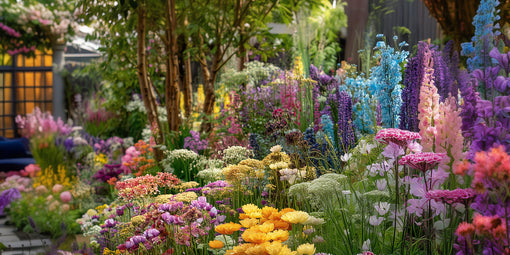
- Article published at:
Drawer menu

Hydrangeas have, for a long time, been a very popular flower for use at weddings and events as well as flowers for your home. They look particularly pretty on their own or with a few stems of eucalyptus in a fishbowl vase on your coffee table. In this post we'll share everything you need to know about the popular cut flower hydrangea.

The hydrangea has been especially significant in Japan, from where the flower is believed to have originated. According to a Japanese legend, the hydrangea became associated with heartfelt emotion, gratitude for understanding, and apology after a Japanese Emperor gave them to the family he loved, to make up for neglecting her in favour of business - and to show how much he cared about her.
There are different theories of where the name hydrangea comes from but, one of them is that, in 1739, the botanist, Grovonius, gave the flower its Latin name hydrangea. He thought the shape resembled an ancient water pitcher.
Combining the words 'hydro' (=water) and 'angeion' (=barrel or pitcher) resulted in the name Hydrangea. The flower also has the more common name, hortensia, that the French botanist Philibert Commerson came up with in 1771.

There are four different types of hydrangeas and these need to be pruned in different ways. The most common hydrangea is the macrophylla and, this is divided into two kinds, the 'mop head' hydrangea and the 'lace cap' hydrangea.
The 'mop head' is the shape of a round ball, and the 'lace cap' has many smaller florets in the centre and open flowers around the outside.
Another type of hydrangea is the arborescens hydrangea, which is popular in designer gardens. The last type is the paniculata hydrangea and they have large cone shaped flowers.

It's important to first decide the spot you want to plant your hydrangea. If you have a sunny spot, you are better of planting peniculata or arborescens varieties. For shady spots, choose the macrophylla types.
The hole should be twice as wide as your plant and the same depth. This allows the roots of the plant to spread out properly. Loosen the soil around the plant and mix in organic matter such as compost to enrich the soil. Gently loosen the roots of your plant before placing it in the hole. Make sure you keep the plant well watered, especially during the first year after planting it.
The 'lace cap' and 'mop head' hydrangeas should be pruned in February or early spring. Just cut off the dead flower heads and the first set of leaves. If you have planted arborescens or peniculata hydrangeas, you need to prune these right down hard to the very first flower buds. This should also be done in February or early spring.

The colour of your hydrangea is determined from the acidity of your soil. The more acidic your soil is, the deeper blue your hydrangea will be. If the hydrangea is growing in a more alkaline soil it will produce pink blooms. You can change the colour of your hydrangea by watering it with acidic infused water during the spring.
White hydrangeas never change colour, except when they grow older, in which case they can turn slightly pink. If you have a light pink hydrangea and you start noticing that it is producing darker pink blooms, this is because the plant is getting old. There is nothing wrong with the plant, but the older it gets, the deeper its colour will become.
Looking for flowers with same day delivery? We at LOV Flowers are happy to announce we now deliver same day within London! Simply place your order before 1pm Monday to Friday. If you need your flowers sent anywhere else in the UK, then choose our free next day flower delivery.
Follow us on Instagram, Facebook and Youtube!